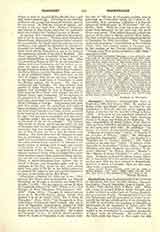

Champollion, JEAN-FRANCOIS (called THE YOUNGER to distinguish him from his elder brother, Champollion-Figeac), French Orientalist, born at Figeac, Lot, December 23, 1790; died in Paris, March 4, 1832. While still young, he studied Hebrew, Syriac Ethiopic, and Arabic, to which he added later on, Persian, Sanskrit, and in particular Coptic. His special field of activity was Egyptology, and his great glory is to have recovered the key for the understanding of the hieroglyphs.
In 1807 he read before the Academy of Grenoble an introduction to the geography of Egypt under the Pharaohs, which he published in 1811. This was intended as the introduction to a complete description of Egypt under the Pharaohs. The publication of the main work was begun in 1814 under the title “L’Egypte sous les Pharaons”; only the first two volumes, bearing on geography, were issued. His efforts to decipher the hieroglyphics began in 1808. By means of the triple inscription of the Rosetta Stone, he succeeded in ascertaining several of the signs, and on September 17, 1822, he read before the Academy of Inscriptions his now famous “Lettre a M. Dacier“, in which he gave the fruits of his researches. The mystery of the hieroglyphics had been solved. With the exception of a brief controversy with Dr. Young, relative to the priority of the discovery, his claims have never been disputed. In 1823 he outlined his system more thoroughly in a series of memoirs read in the Institute. These memoirs were put together and printed under the title “Precis du systeme hieroglyphique des anciens Egyptiens” (Paris, 1824; 2nd ed., 2 vols., 1828). In 1824 he was sent to Italy by the King of France on a scientific mission, and on his recommendation a rich collection of Egyptian antiquities was secured by the Musee du Louvre. It was during his sojourn in Italy that he catalogued the Egyptian monuments of Naples, Florence, and Rome. Appointed curator of the Egyptian Museum of the Louvre, he issued his “Notice descriptive des monuments egyptiens du musee Charles X” (Paris, 1827). He then received a commission to explore Egypt, in the company of Rosellini. The enthusiastic letters which he wrote were published day by day; after his death, they were reprinted in book form by his brother, in 1833, and again by his daughter, in 1868. In 1830 he was named member of the Academy of Inscriptions and elected to the chair of Egyptian archaeology, founded for him at the College de France. Soon, however, he retired to Quercy, and devoted the last months of his life to the completion and revision of his Egyptian grammar and dictionary. He was a genius, but it is the testimony of all those who came in contact with him that the man was even better than the scholar.
Among his other works were “Deux lettres a M. le due de Blacas d’Aulps, relatives au musee royal egyptien de Turin” (Paris, 1824-1826); “Catalogue des monuments egyptiens du musee du Vatican” (Rome, 1826); “Pantheon egyptien”, etc. (1823-1831), published in parts, the whole work was to have formed two volumes, but was not completed. His manuscripts were acquired by the French Government and published by his brother. Among these posthumous works, the most important are: “Monuments de Aegypte et de la Nubie d’apres les dessins executes sur lea lieux”, etc., 4 vols. (Paris, 1835-1845); “Monuments de Aegypte et de la Nubie, notices descriptives” (Paris, 1844-1874); “Grammaire egyptienne”, 3 parts (Paris, 1836-1841); “Dictionnaire egyptien en ecriture hieroglyphique”, in 4 parts (Paris, 1841-1844).
R. BUTIN

